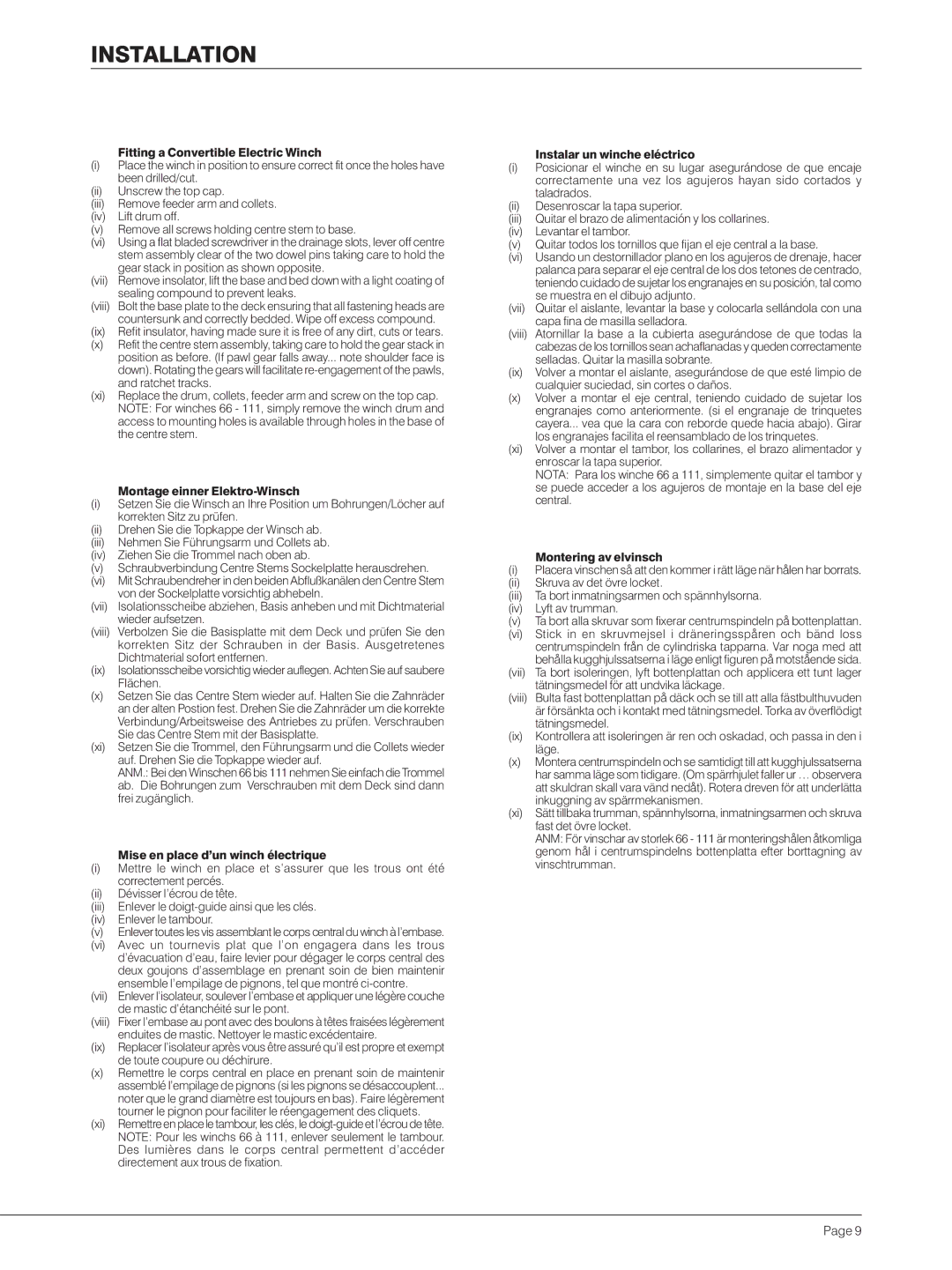Fitting a Convertible Electric Winch
(i)Place the winch in position to ensure correct fit once the holes have been drilled/cut.
(ii)Unscrew the top cap.
(iii)Remove feeder arm and collets.
(iv)Lift drum off.
(v)Remove all screws holding centre stem to base.
(vi)Using a flat bladed screwdriver in the drainage slots, lever off centre stem assembly clear of the two dowel pins taking care to hold the gear stack in position as shown opposite.
(vii)Remove insolator, lift the base and bed down with a light coating of sealing compound to prevent leaks.
(viii)Bolt the base plate to the deck ensuring that all fastening heads are countersunk and correctly bedded. Wipe off excess compound.
(ix)Refit insulator, having made sure it is free of any dirt, cuts or tears.
(x)Refit the centre stem assembly, taking care to hold the gear stack in position as before. (If pawl gear falls away... note shoulder face is down). Rotating the gears will facilitate re-engagement of the pawls, and ratchet tracks.
(xi)Replace the drum, collets, feeder arm and screw on the top cap. NOTE: For winches 66 - 111, simply remove the winch drum and access to mounting holes is available through holes in the base of the centre stem.
Montage einner Elektro-Winsch
(i)Setzen Sie die Winsch an Ihre Position um Bohrungen/Löcher auf korrekten Sitz zu prüfen.
(ii)Drehen Sie die Topkappe der Winsch ab.
(iii)Nehmen Sie Führungsarm und Collets ab.
(iv)Ziehen Sie die Trommel nach oben ab.
(v)Schraubverbindung Centre Stems Sockelplatte herausdrehen.
(vi)Mit Schraubendreher in den beiden Abflußkanälen den Centre Stem von der Sockelplatte vorsichtig abhebeln.
(vii)Isolationsscheibe abziehen, Basis anheben und mit Dichtmaterial wieder aufsetzen.
(viii)Verbolzen Sie die Basisplatte mit dem Deck und prüfen Sie den korrekten Sitz der Schrauben in der Basis. Ausgetretenes Dichtmaterial sofort entfernen.
(ix)Isolationsscheibe vorsichtig wieder auflegen. Achten Sie auf saubere Flächen.
(x)Setzen Sie das Centre Stem wieder auf. Halten Sie die Zahnräder an der alten Postion fest. Drehen Sie die Zahnräder um die korrekte Verbindung/Arbeitsweise des Antriebes zu prüfen. Verschrauben Sie das Centre Stem mit der Basisplatte.
(xi)Setzen Sie die Trommel, den Führungsarm und die Collets wieder auf. Drehen Sie die Topkappe wieder auf.
ANM.: Bei den Winschen 66 bis 111 nehmen Sie einfach die Trommel ab. Die Bohrungen zum Verschrauben mit dem Deck sind dann frei zugänglich.
Mise en place d’un winch électrique
(i)Mettre le winch en place et s’assurer que les trous ont été correctement percés.
(ii)Dévisser l’écrou de tête.
(iii)Enlever le doigt-guide ainsi que les clés.
(iv)Enlever le tambour.
(v)Enlever toutes les vis assemblant le corps central du winch à l’embase.
(vi)Avec un tournevis plat que l’on engagera dans les trous d’évacuation d’eau, faire levier pour dégager le corps central des deux goujons d’assemblage en prenant soin de bien maintenir ensemble l’empilage de pignons, tel que montré ci-contre.
(vii)Enlever l’isolateur, soulever l’embase et appliquer une légère couche de mastic d’étanchéité sur le pont.
(viii)Fixer l’embase au pont avec des boulons à têtes fraisées légèrement enduites de mastic. Nettoyer le mastic excédentaire.
(ix)Replacer l’isolateur après vous être assuré qu’il est propre et exempt de toute coupure ou déchirure.
(x)Remettre le corps central en place en prenant soin de maintenir assemblé l’empilage de pignons (si les pignons se désaccouplent...
noter que le grand diamètre est toujours en bas). Faire légèrement tourner le pignon pour faciliter le réengagement des cliquets.
(xi)Remettre en place le tambour, les clés, le doigt-guide et l’écrou de tête. NOTE: Pour les winchs 66 à 111, enlever seulement le tambour. Des lumières dans le corps central permettent d’accéder directement aux trous de fixation.
Instalar un winche eléctrico
(i)Posicionar el winche en su lugar asegurándose de que encaje correctamente una vez los agujeros hayan sido cortados y taladrados.
(ii)Desenroscar la tapa superior.
(iii)Quitar el brazo de alimentación y los collarines.
(iv)Levantar el tambor.
(v)Quitar todos los tornillos que fijan el eje central a la base.
(vi)Usando un destornillador plano en los agujeros de drenaje, hacer palanca para separar el eje central de los dos tetones de centrado, teniendo cuidado de sujetar los engranajes en su posición, tal como se muestra en el dibujo adjunto.
(vii)Quitar el aislante, levantar la base y colocarla sellándola con una capa fina de masilla selladora.
(viii)Atornillar la base a la cubierta asegurándose de que todas la cabezas de los tornillos sean achaflanadas y queden correctamente selladas. Quitar la masilla sobrante.
(ix)Volver a montar el aislante, asegurándose de que esté limpio de cualquier suciedad, sin cortes o daños.
(x)Volver a montar el eje central, teniendo cuidado de sujetar los engranajes como anteriormente. (si el engranaje de trinquetes cayera... vea que la cara con reborde quede hacia abajo). Girar los engranajes facilita el reensamblado de los trinquetes.
(xi)Volver a montar el tambor, los collarines, el brazo alimentador y enroscar la tapa superior.
NOTA: Para los winche 66 a 111, simplemente quitar el tambor y se puede acceder a los agujeros de montaje en la base del eje central.
Montering av elvinsch
(i)Placera vinschen så att den kommer i rätt läge när hålen har borrats.
(ii)Skruva av det övre locket.
(iii)Ta bort inmatningsarmen och spännhylsorna.
(iv)Lyft av trumman.
(v)Ta bort alla skruvar som fixerar centrumspindeln på bottenplattan.
(vi)Stick in en skruvmejsel i dräneringsspåren och bänd loss centrumspindeln från de cylindriska tapparna. Var noga med att behålla kugghjulssatserna i läge enligt figuren på motstående sida.
(vii)Ta bort isoleringen, lyft bottenplattan och applicera ett tunt lager tätningsmedel för att undvika läckage.
(viii)Bulta fast bottenplattan på däck och se till att alla fästbulthuvuden är försänkta och i kontakt med tätningsmedel. Torka av överflödigt tätningsmedel.
(ix)Kontrollera att isoleringen är ren och oskadad, och passa in den i läge.
(x)Montera centrumspindeln och se samtidigt till att kugghjulssatserna har samma läge som tidigare. (Om spärrhjulet faller ur … observera att skuldran skall vara vänd nedåt). Rotera dreven för att underlätta inkuggning av spärrmekanismen.
(xi)Sätt tillbaka trumman, spännhylsorna, inmatningsarmen och skruva fast det övre locket.
ANM: För vinschar av storlek 66 - 111 är monteringshålen åtkomliga genom hål i centrumspindelns bottenplatta efter borttagning av vinschtrumman.

